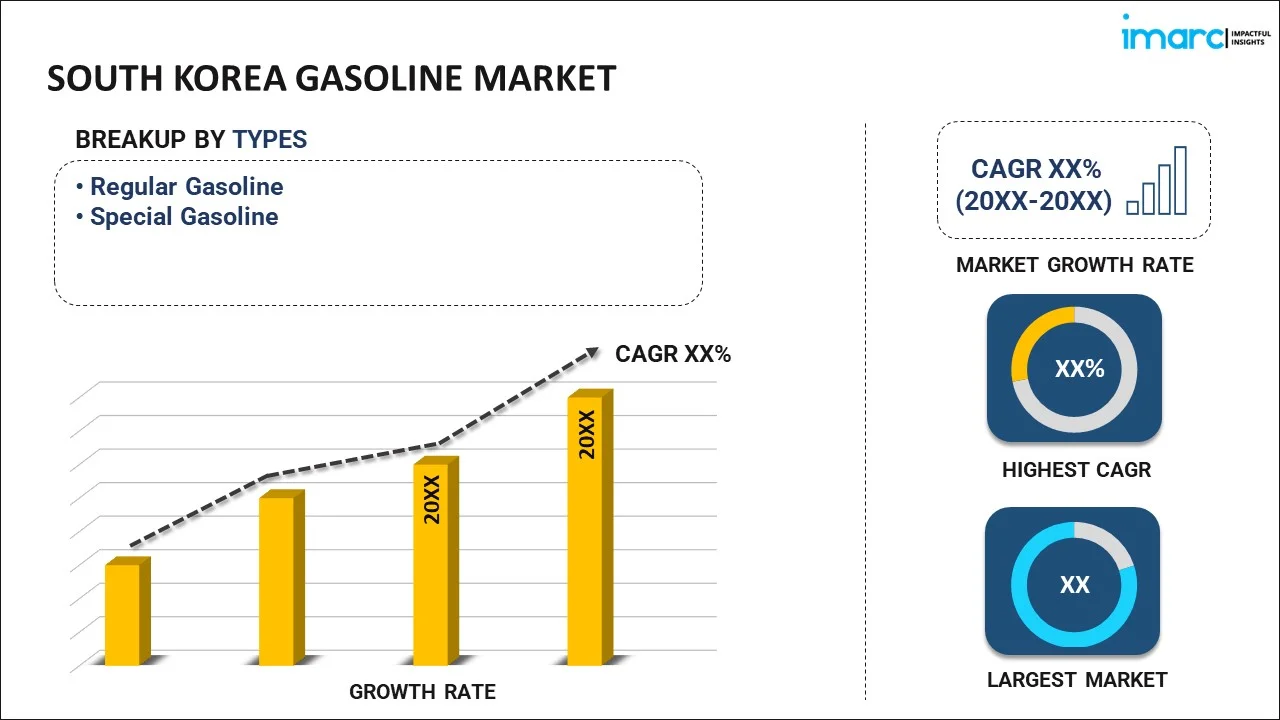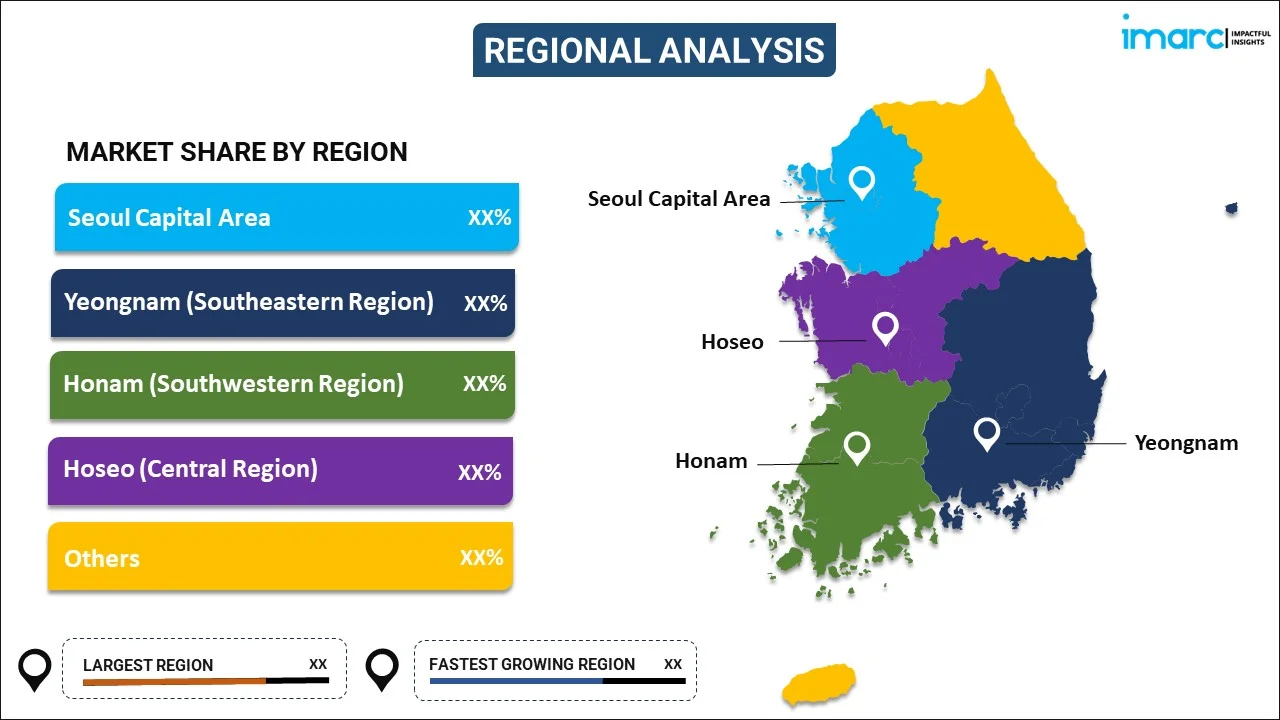
South Korea Gasoline Market Report by Type (Regular Gasoline, Special Gasoline), Application (Motorcycle, Automobile, and Others), and Region 2025-2033
Market Overview:
South Korea gasoline market size reached USD 2.5 Billion in 2024. Looking forward, IMARC Group expects the market to reach USD 2.7 Billion by 2033, exhibiting a growth rate (CAGR) of 1.1% during 2025-2033. The rising sales of passenger and commercial vehicles, continuous advancements in engine technology and fuel efficiency, and increasing construction of residential and commercial buildings, highways, and roads represent some of the key factors driving the market.
|
Report Attribute
|
Key Statistics
|
|---|---|
|
Base Year
|
2024
|
|
Forecast Years
|
2025-2033
|
|
Historical Years
|
2019-2024
|
| Market Size in 2024 | USD 2.5 Billion |
| Market Forecast in 2033 | USD 2.7 Billion |
| Market Growth Rate 2025-2033 | 1.1% |
Gasoline is a pale yellow or colorless liquid fuel derived from crude oil through a refining process. It mainly comprises hydrocarbons, including alkanes, cycloalkanes, and some additives like detergents and anti-knock agents. It has a relatively low density, making it convenient for transportation and storage. It has a moderate volatility, allowing for easy vaporization and ignition within the engine. It offers high energy content, making it an efficient fuel for internal combustion engines. It powers a wide range of vehicles, ranging from cars and motorcycles to small engines like lawnmowers. It has a longer shelf life and is widely used to fuel cars, trucks, motorcycles, and boats. It is also utilized in small engines, such as generators, chainsaws, and lawnmowers. It fuels recreational vehicles like jet skis, snowmobiles, and all-terrain vehicles (ATVs). Besides this, as it provides backup power during outages, the demand for gasoline is increasing in South Korea.
South Korea Gasoline Market Trends:
Robust economic growth and increasing sales of passenger and commercial vehicles in South Korea represent one of the primary factors driving the demand for gasoline. Additionally, the rising trend of cleaner transportation options is offering a favorable market outlook. Along with this, the expanding refining capacity for gasoline production in South Korea is strengthening the growth of the market. Apart from this, continuous advancements in engine technology and fuel efficiency are increasing the use of gasoline-powered vehicles among individuals. Moreover, the governing authorities of South Korea are introducing various policies and initiatives to promote the use of cleaner and more efficient fuels, including gasoline. These policies include tax incentives for eco-friendly vehicles and stricter emissions standards. Such measures encourage the adoption of gasoline-powered vehicles that meet environmental requirements, further driving the market. Furthermore, increasing construction of residential and commercial buildings, highways, and roads are driving the demand for gasoline. In addition, the rising environmental consciousness among the masses and rising sales of hybrid and eco-friendly gasoline-electric vehicles are driving innovation in the gasoline sector. The rising trend of ride-sharing services and autonomous cars is also offering a favorable market outlook. In line with this, continuous investments in infrastructure for alternative fuels, including liquefied natural gas (LNG) and hydrogen, are creating a positive outlook for the market. Besides this, several companies are constantly working to improve the quality of their gasoline products, reduce emissions, and enhance fuel efficiency. Furthermore, the increasing reliance on gasoline-powered transportation for sightseeing and travel within the country is bolstering the market growth.
South Korea Gasoline Market Segmentation:
IMARC Group provides an analysis of the key trends in each segment of the market, along with forecasts at the country level for 2025-2033. Our report has categorized the market based on type and application.
Type Insights:

- Regular Gasoline
- Special Gasoline
The report has provided a detailed breakup and analysis of the market based on the type. This includes regular gasoline and special gasoline.
Application Insights:
- Motorcycle
- Automobile
- Others
A detailed breakup and analysis of the market based on the application have also been provided in the report. This includes motorcycle, automobile, and others.
Regional Insights:

- Seoul Capital Area
- Yeongnam (Southeastern Region)
- Honam (Southwestern Region)
- Hoseo (Central Region)
- Others
The report has also provided a comprehensive analysis of all the major regional markets, which include Seoul Capital Area, Yeongnam (Southeastern Region), Honam (Southwestern Region), Hoseo (Central Region), and Others.
Competitive Landscape:
The market research report has also provided a comprehensive analysis of the competitive landscape in the market. Competitive analysis such as market structure, key player positioning, top winning strategies, competitive dashboard, and company evaluation quadrant has been covered in the report. Also, detailed profiles of all major companies have been provided.
South Korea Gasoline Market Report Coverage:
| Report Features | Details |
|---|---|
| Base Year of the Analysis | 2024 |
| Historical Period | 2019-2024 |
| Forecast Period | 2025-2033 |
| Units | Billion USD |
| Scope of the Report | Exploration of Historical Trends and Market Outlook, Industry Catalysts and Challenges, Segment-Wise Historical and Future Market Assessment:
|
| Types Covered | Regular Gasoline, Special Gasoline |
| Applications Covered | Motorcycle, Automobile, Others |
| Regions Covered | Seoul Capital Area, Yeongnam (Southeastern Region), Honam (Southwestern Region), Hoseo (Central Region), Others |
| Customization Scope | 10% Free Customization |
| Post-Sale Analyst Support | 10-12 Weeks |
| Delivery Format | PDF and Excel through Email (We can also provide the editable version of the report in PPT/Word format on special request) |
Key Questions Answered in This Report:
- How has the South Korea gasoline market performed so far and how will it perform in the coming years?
- What has been the impact of COVID-19 on the South Korea gasoline market?
- What is the breakup of the South Korea gasoline market on the basis of type?
- What is the breakup of the South Korea gasoline market on the basis of application?
- What are the various stages in the value chain of the South Korea gasoline market?
- What are the key driving factors and challenges in the South Korea gasoline?
- What is the structure of the South Korea gasoline market and who are the key players?
- What is the degree of competition in the South Korea gasoline market?
Key Benefits for Stakeholders:
- IMARC’s industry report offers a comprehensive quantitative analysis of various market segments, historical and current market trends, market forecasts, and dynamics of the South Korea gasoline market from 2019-2033.
- The research report provides the latest information on the market drivers, challenges, and opportunities in the South Korea gasoline market.
- Porter's five forces analysis assist stakeholders in assessing the impact of new entrants, competitive rivalry, supplier power, buyer power, and the threat of substitution. It helps stakeholders to analyze the level of competition within the South Korea gasoline industry and its attractiveness.
- Competitive landscape allows stakeholders to understand their competitive environment and provides an insight into the current positions of key players in the market.
Need more help?
- Speak to our experienced analysts for insights on the current market scenarios.
- Include additional segments and countries to customize the report as per your requirement.
- Gain an unparalleled competitive advantage in your domain by understanding how to utilize the report and positively impacting your operations and revenue.
- For further assistance, please connect with our analysts.
 Request Customization
Request Customization
 Speak to an Analyst
Speak to an Analyst
 Request Brochure
Request Brochure
 Inquire Before Buying
Inquire Before Buying




.webp)




.webp)












